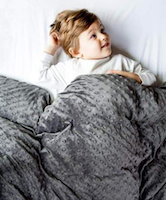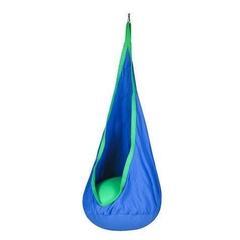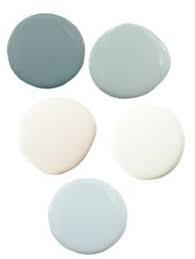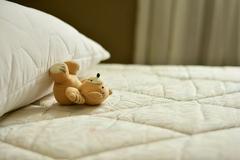Your Cart is Empty
Save up to 20% on all Harkla products & courses during Autism Acceptance Month! Click Here to See the Sale

It is estimated that over 80% of children with autism experience difficulties with sleep. If you’ve read our Ultimate Guide to Improving Sleep, you’re likely on your way to considering how to best support your child’s own sleep habits.
Looking at your child’s bedroom environment may offer some insights and potential solutions.
Well-designed bedrooms for children with autism appeal to functionality, meet sensory needs, provide safety reassurance, and promote independence. But just because there’s a lot to consider, doesn’t mean your child’s bedroom can’t be cute and fun too!

Unless you’re lucky enough to have a dedicated play space in your home, your child’s bedroom is likely packed full of toys, stuffed animals, games, and collectibles.
Consider defining spaces within your child’s room for play, sleep, work, and storage so you can contain the potential chaos and further identify behavioral expectations.

Clear stackable drawers can be easily labeled with pictures, symbols, or words according to your child’s needs.Your child’s bedroom should be a place to be calm, relax, and sleep when needed. It’s hard to decompress when there is clutter and mess surrounding your quiet space, so if it’s too difficult to limit the “stuff,” try to contain it with functional storage options.
Make your storage solutions simple to foster independence with cleaning up and accessing materials when needed. Read moreabout how organization promotes executive functioning, reduces anxiety, and fosters independence.
If you haven’t read our blog article on how lighting can impact your child’s sensory system, do! You’ll look at your child’s bedroom through a different lens - so to speak. Consider the following design ideas to adjust for the light influences in your child’s room:

This is when your child’s sensory preferences are most important to keep in mind. Choose fabrics that appeal to him and are soft and snuggly: cotton, flannel, sateen, or t-shirt materials. Consider patterns and prints that are fun but not overly stimulating.
Weighted blankets and heavy comforters can support sleep patterns because they provide deep touch pressure sensory input. For more information on weighted blanket research, check out this article.
Another option is the Harkla compression sheet! A compression sheet also provides deep touch pressure which regulates your child's nervous system (just like a hug!). The compression sheet offers great sensory input helping your child feel safe and relaxed.

If you’ve got a multi-tasking bedroom, be sure to include a kid-size table/desk and chair set to allow for tabletop play, coloring, and drawing.
Consider a soft place to crash and an active seating option like a t-stool, ball chair, or small rocking chair that will allow your sensory kiddo to move or rock while they sit.
Check out the Harkla sensory pod swing and some active seating options here.
Another idea is the Harkla Hug, which is one of our newest products here at Harkla!
Whether it’s a bed tent, a tent in the corner, or a canopy over a pile of soft pillows, it is important to provide your child with a sensory deprivation area.
This may or may not be located in your child’s bedroom, but it is possible to include elements in their sleeping space. A sensory deprivation area could include: soft pillows, noise-canceling headphones, preferred stim toys and/or fidget tools, and a weighted lap pad. This space promotes self-regulation and reorganization.
If you want to learn more, read our article on creating sensory rooms!

We all love bright, fun colors for kids but sometimes those primary rainbow colors aren’t exactly promoting calm and tranquility. There is a psychology behind why we choose the colors we surround ourselves with -- and why we should avoid color placement in certain situations.
For example, did you know that yellow is the color most likely to cause eye strain and visual fatigue? If light and visual sensitivity is a consideration for your child, consider a darker hue like gray, navy, soft blue, or violet that absorb more light instead of reflecting it.
Red evokes strong emotions, while blues and greens are associated with calm and tranquility. If you’ve got your heart set on hot pink, perhaps consider toning it down a few notches on the color swatch and neutralizing the rest of your child’s bedroom design.

Bed designs can be basic or geared to your child’s interests - but the mattress should be a consideration.
Memory foam, spring, or hybrid mattresses all offer different sensory experiences. If you’ve got a restless sleeper or a child who is prone to jumping on his springy bed, perhaps consider a hybrid mattress for a less alerting and more forgiving surface.
Memory foam, while great for some, can give sleepers a ‘sinking’ sensation that some kids may not respond well to.
The noises around us can be alerting, over stimulating, irritating, or startling. If your child’s room is near a busy street, the neighbor’s barking dog, or busy hallway in your home, the stimulation from these outside sources is something to consider. A white noise machine or low-playing music can help.
You’ve gotten your little one all set up for sleep success...but it’s likely not solving all of his sleep/wake problems! As his bedtime routines and circadian rhythms adjust, try a smart alarm clock designed with kids in mind.
If your child has trouble knowing when it’s okay to get up for the day, check out the OK to Wake Alarm Clock. For those kids who need a night light and some help waking in the morning, try the Wake-Up Light that gradually brightens as morning approaches.
Sensory-informed bedroom design is becoming more mainstream. At Harkla, we offering sensory-friendly options that meet differing needs. For more information on sleep issues and autism, be sure to check out the Harkla blog for more tips and tricks.
My name Brad ..my wife and I lost our son ..16 months ago..He left behind his 10 year old autistic beautiful son..His Mother left 4 years ago..so we have started over…we adopted him Dec. 1..our grandson….things I have found out ..i have pay attention to the world he lives in ..which is different to ours.the charactures he portrays ..how he interacts w them..How he watches his tablet ..the things he acts out with them.ive learned his world and 8 hours a day I live in his world ..and I love it ..and appreciate him so much more for who he is..He has learned so much just watching his tablet and his charactures using there speech at the right time to tell me something …i also set up free coding on computer .code monkey..and the 10 hour of coding they gave him free he did at different times..took him 3..hours..be ready for special surprises..and please try there world .it is wonderful..and yes I am 65 and retiring could not be better..they all need to know we love them and will always be there..they understand more than u think…
This is great! However, can you consider changing the language “sensory deprivation area”? Ideally, we don’t want to deprive kids of sensory input, and “sensory deprivation” brings to mind forcibly depriving someone of all sensory input. Deprivation is denial and refusal, typically of something someone needs or wants. Maybe call it a “sensory reduction area”, or a “sensory relief area”?
Hi Rain,
We’re so glad you liked it. Thanks for reading!
-Nicole from Harkla
Very helpful post!
Hi Stella,
We’re so glad you found this post helpful!
Take care,
Nicole
Harkla Happiness Ninja
Hi Onita,
I really admire you for the effort you’re putting into accommodating your nephew. We have other articles on our blog about creating a sensory space for your child. Also, please be sure to read our articles about how to support the needs of kids with autism, SPD, and other diagnoses. Feel free to contact us directly if you have more questions!
All the best,
Nicole
Harkla Happiness Ninja
Hello,
My name is Onita, I have a autistic nephew he is 9 years old. My mother who recently passed used to primarily take care of him and I would provide whatever help and assistance she needed. I am moving in about 3 months and my nephew will be going with me. I want to make sure his space (bedroom) is well equipt currently he doesnt really have a space all his own currently, he used to sleep in the same room with my mom etc. But now he will have his own room and I want it to be a space he will enjoy. I saw some of the tips you had and I have gotten the ebooks sent to my email. Any additional info will be helpful. I will be setting up speech therapy so he will be able to communicate his needs better. He does have a ipad where he uses the program to say what he wants.
I read your post. It’s quite very interesting and informative.I usually purchase the furniture for my home and office from get.furniture at an affordable price. They provide the best quality of products and quick services on time. Thanks for this lovely post.
Comments will be approved before showing up.



Troy
September 26, 2023
How about directions for a 5 year old with moderate to severe autism. I guarantee that if we followed this advice, we’d be picking the mess up every day multiple times a day. Our son ripped up his carpeting and padding at age 3.5. These directions wouldn’t work for every level of ASD or for younger ages.